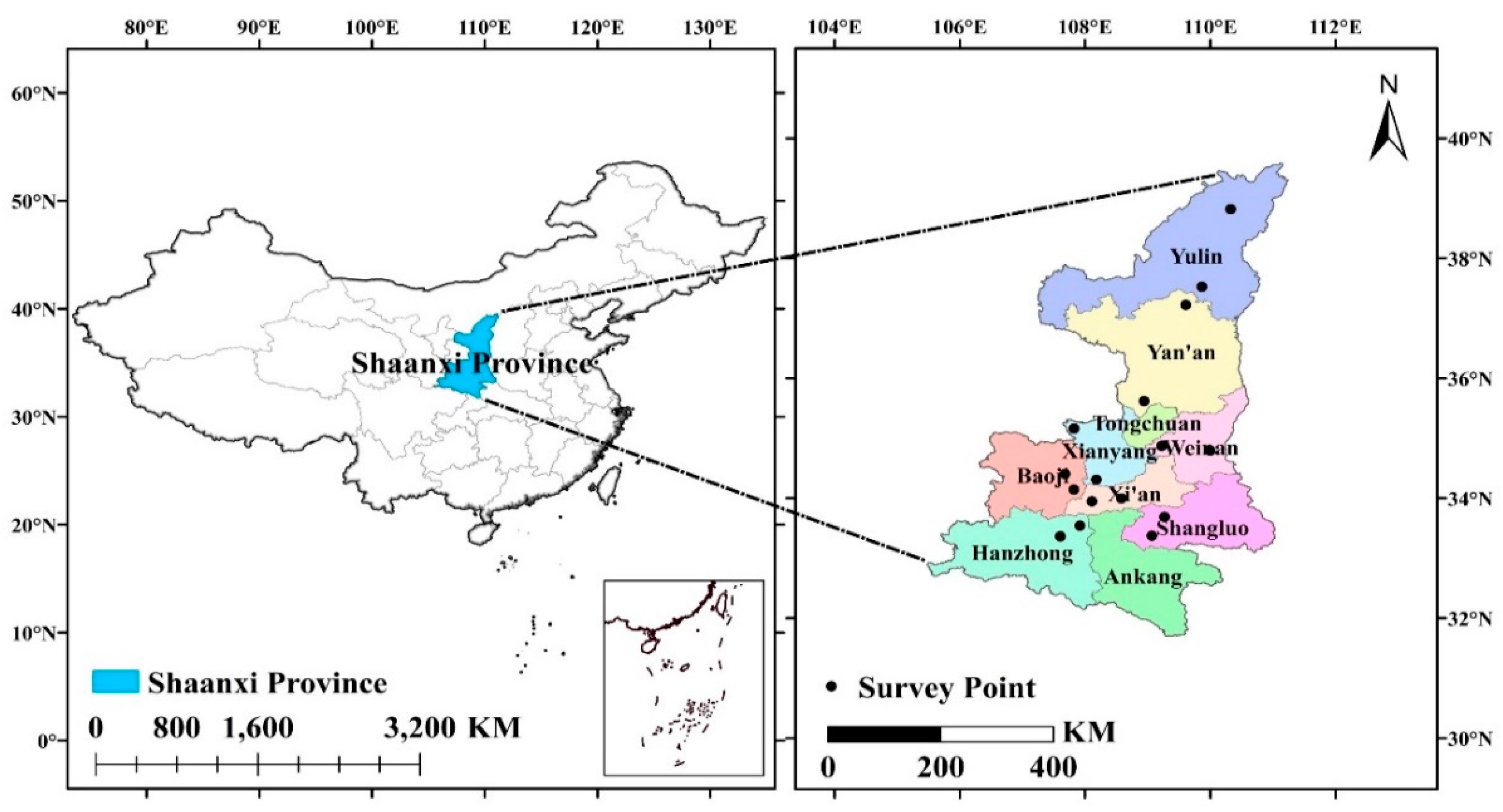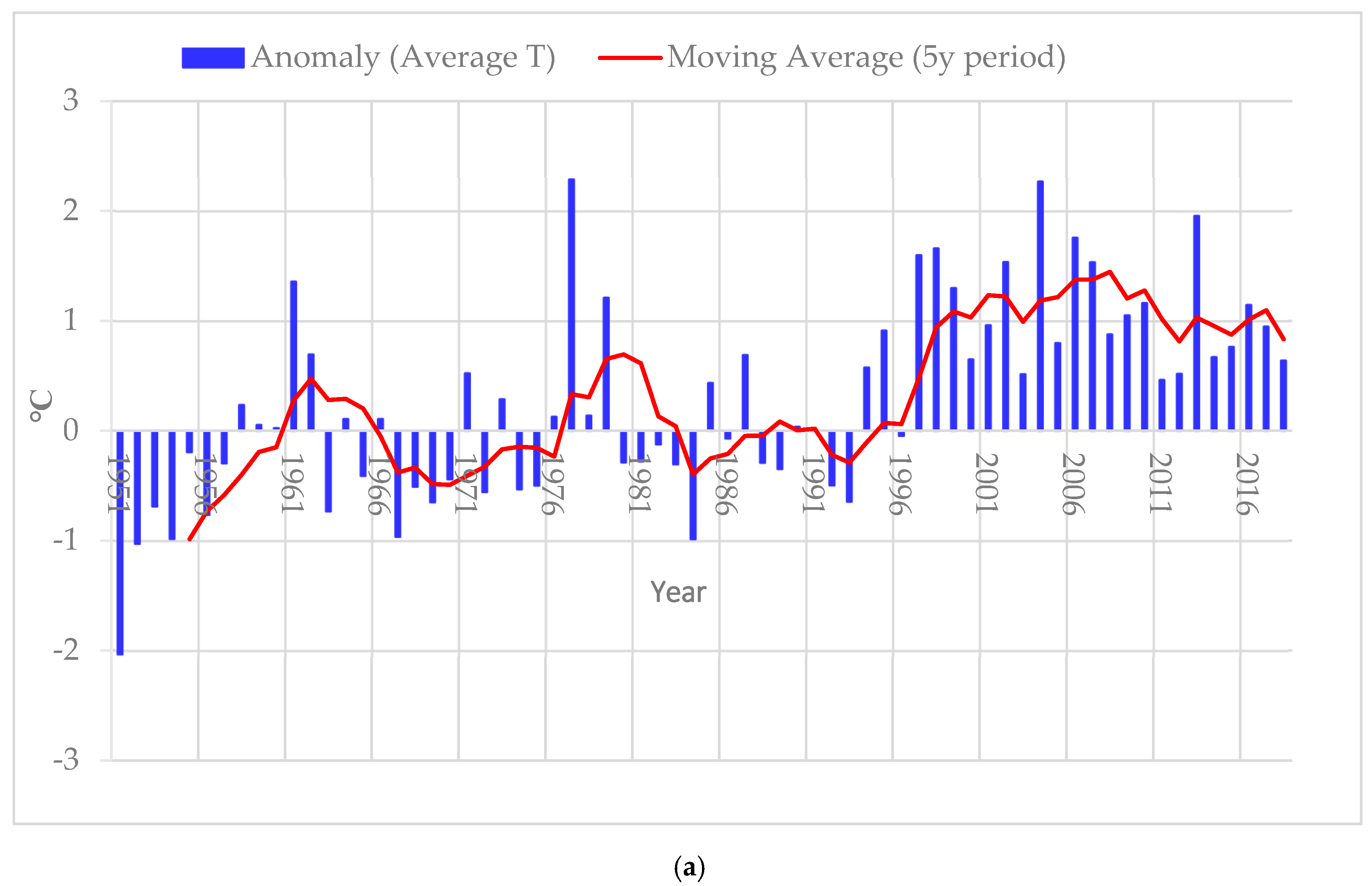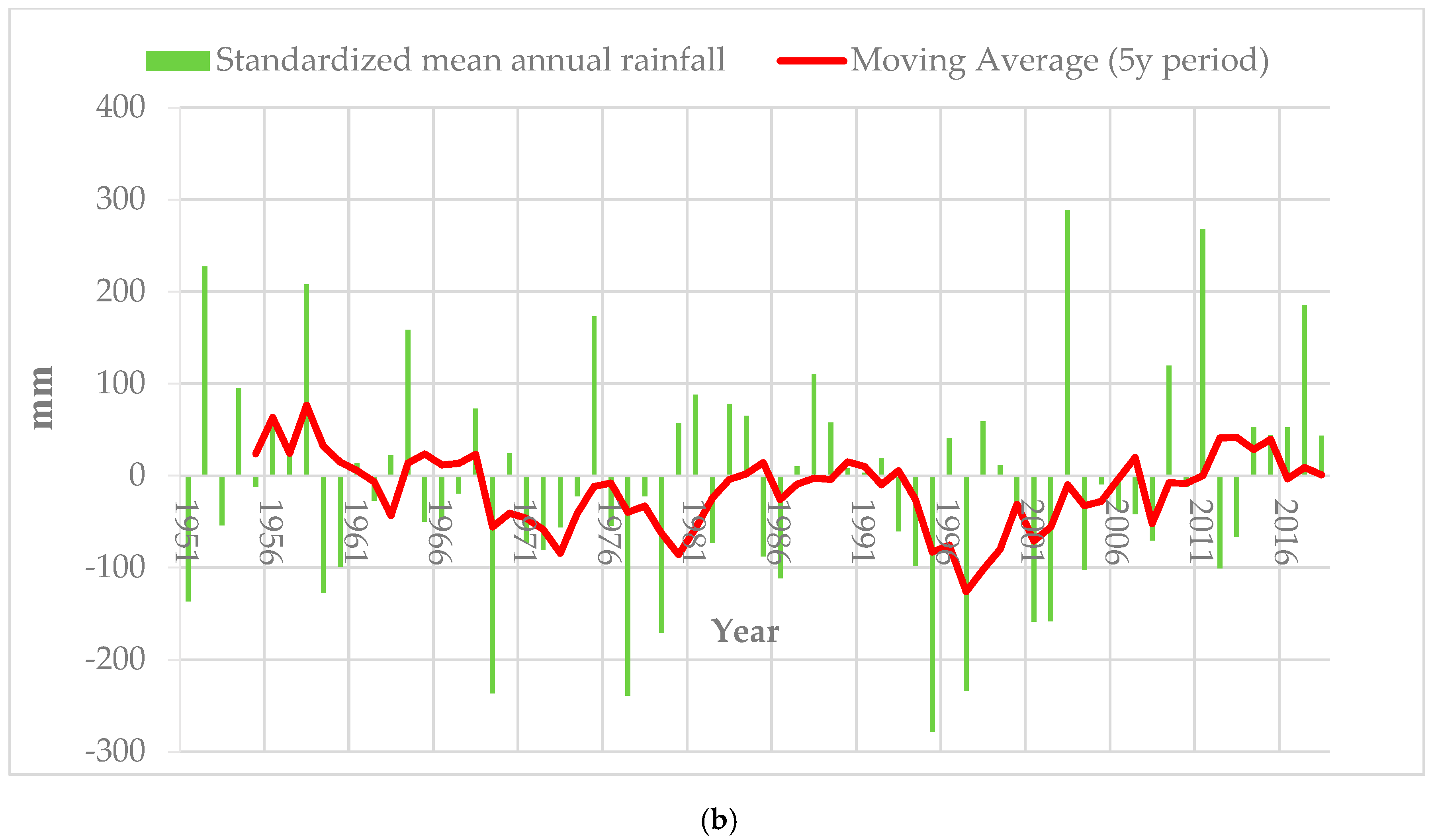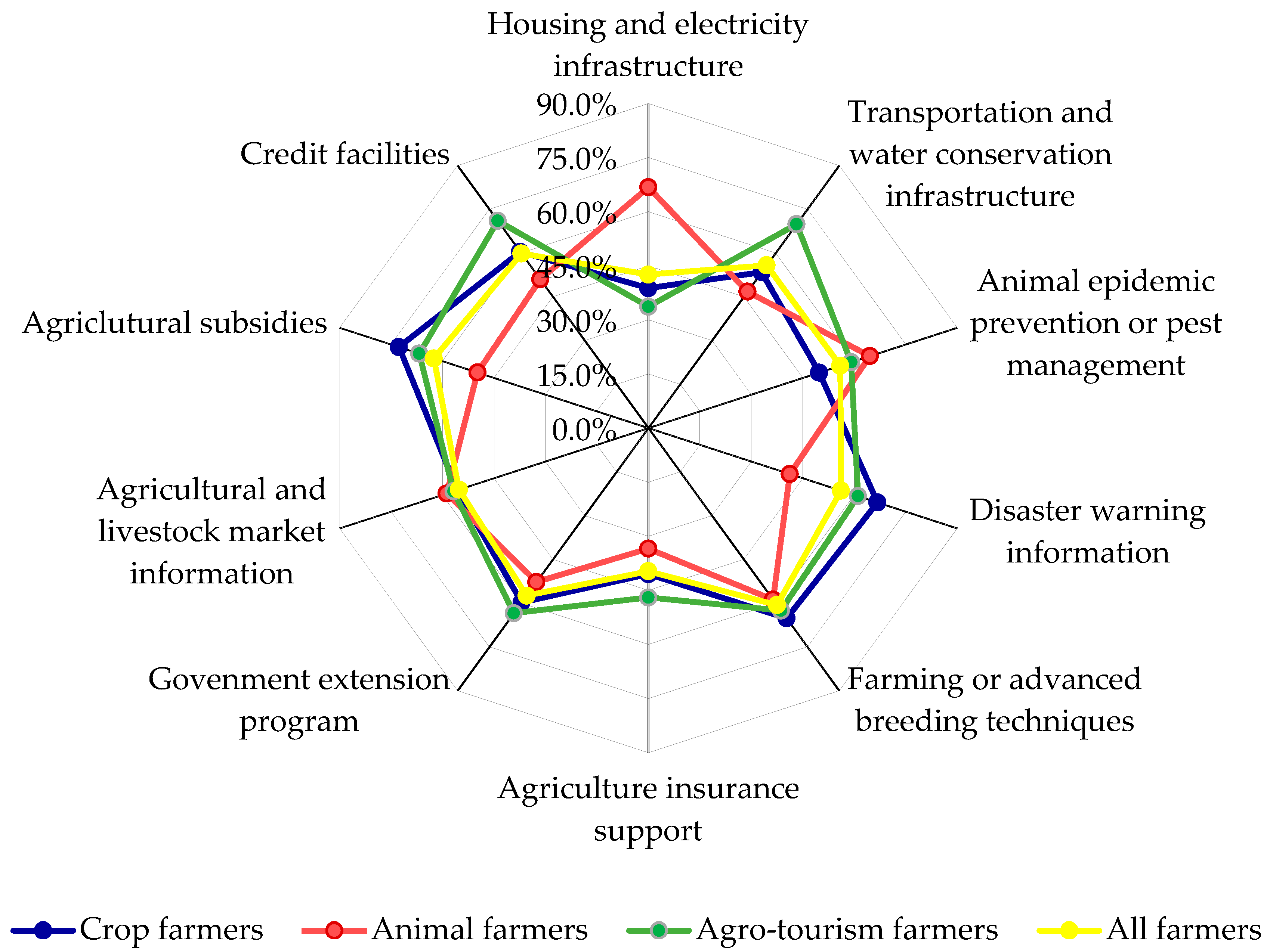Identifying Barriers and Enablers for Climate Change Adaptation of Farmers in Semi-Arid North-Western China
Abstract
1. Introduction
2. Research Methodology
2.1. Study Site Description and Long-Term Climate Trend
2.2. Survey Design and Data Collection
2.3. Method of Barrier Index () Calculation
- Step 1 Establish the original evaluation matrix:
- Step 2 Establish normalized matrix Z as Equation (2):
- Step 3 Measure the distance from each alternative to the negative idea solution and the positive ideal solution as Equations (3) and (4):where means the distance between the positive ideal solution and the ith alternative, while represents the distance between the negative ideal solution and the ith alternative. Where and .
- Step 4 Calculate the relative closeness to the ideal solution as Equation (5):where belongs to [0, 1], the case with closest to 1, which is the target case
- Step 5 Calculate the barrier index () as Equation (6):where belongs to [0, 1], being the case with closest to 0, which means the lowest obstacles to adaptation faced by the producers.
2.4. Data Analysis
3. Results
3.1. Attitudes and Agricultural Disasters Related to Climate Change
3.2. Climate Barriers for Adaptation
3.2.1. Institutional Barriers ( = 0.611)
3.2.2. Normative Barriers ( = 0.551)
3.2.3. Information and Technology Barriers ( = 0.512)
3.2.4. Perception Barriers ( = 0.460)
3.3. Climate Enablers for Adaptation
4. Discussion
4.1. Farmers’ Attitudes toward Climate Change
4.2. Factors Influencing Farmers’ Adaptation Barriers and Enablers
5. Conclusions
6. Policy Implications
Author Contributions
Funding
Conflicts of Interest
References
- Popoola, O.O.; Yusuf, S.F.G.; Monde, N. Information sources and constraints to climate change adaptation amongst smallholder farmers in Amathole district municipality, Eastern cape province, South Africa. Sustainability 2020, 12, 5846. [Google Scholar] [CrossRef]
- Wahid, U.; Muhammad, N.; Muhammad, K.; Takaaki, N. Assessing farmers’ perspective on climate change for effective farm-level adaptation measures in Khyber Pakhtunkhwa, Pakistan. Environ. Monitor. Assess. 2019, 191, 1–18. [Google Scholar]
- IPCC Secretariat, 2018. Summary of Policy Makers of IPCC: Special Report on Global Warming of 1.5 °C Approved by Governments. Geneva, Switzerland, 1–5. Available online: https://www.scirp.org/reference/ReferencesPapers.aspx?ReferenceID=2521802 (accessed on 9 September 2020).
- Cadez, S.; Czerny, A. Climate change mitigation strategies in carbon-intensive firms. J. Clean. Prod. 2016, 112, 4132–4143. [Google Scholar] [CrossRef]
- Czerny, A.; Letmathe, P. Eco-efficiency: GHG reduction related environmental and economic performance. The case of the companies participating in the EU emissions trading scheme. Bus. Strat. Environ. 2017, 26, 791–806. [Google Scholar] [CrossRef]
- Cadez, S.; Czerny, A.; Letmathe, P. Stakeholder pressures and corporate climate change mitigation strategies. Bus. Strat. Environ. 2019, 28, 1–14. [Google Scholar] [CrossRef]
- Talbot, D.; Boiral, O. Strategies for climate change and impression management: A case study among Canada’s large industrial emitters. J. Bus. Ethics 2015, 132, 329–346. [Google Scholar] [CrossRef]
- Cadez, S.; Guilding, C. Examining district carbon cost structures and climate change abatement strategies in CO2 polluting firms. Account. Audit. Account. J. 2017, 30, 1041–1064. [Google Scholar] [CrossRef]
- Huang, K.C.; Lee, C.J.; Chan, S.L.; Tai, C.H. Vulnerability assessment and adaptation strategies for the impact of climate change on agricultural land in Southern Taiwan. Sustainability 2020, 12, 4637. [Google Scholar] [CrossRef]
- Ghanian, M.; Ghoochani, O.M.; Dehghanpour, M.; Taqipour, M.; Taheri, F.; Cotton, M. Understanding farmers’ climate adaptation intention in Iran: A protection motivation extended model. Land Use Policy 2020, 94, 104553. [Google Scholar] [CrossRef]
- Khanal, U.; Wilson, C. Derivation of a climate adaptation index and assessing determinants and barriers to adaptation among farming households in Nepal. Environ. Sci. Policy 2019, 101, 156–165. [Google Scholar] [CrossRef]
- Ado, A.M.; Jin, L.S.; Savadogo, P.; Li, B.; Shah, A.A. Farmers’ awareness and perception of climate change impacts: Case study of Aguie district in Niger. Environ. Dev. Sustain. 2019, 21, 2963–2977. [Google Scholar] [CrossRef]
- Altieri, M.A.; Nicholls, C.I. The adaptation and mitigation potential of traditional agriculture in a changing climate. Clim. Chang. 2017, 140, 33–45. [Google Scholar] [CrossRef]
- Masud, M.M.; Azam, M.N.; Mohiuddin, M.; Banna, H.; Akhtar, R.; Alam, A.S.A.F.; Begum, H. Adaptation barriers and strategies towards climate change: Challenges in the agricultural sector. J. Clean. Prod. 2017, 156, 698–706. [Google Scholar] [CrossRef]
- Fahad, S.; Wang, J. Farmers’ risk perception, vulnerability, and adaptation to climate change in rural Pakistan. Land Use Policy 2018, 79, 301–309. [Google Scholar] [CrossRef]
- Asseng, S.; Pannell, D.J. Adapting dryland agriculture to climate change: Farming implications and research and development needs in Western Australia. Clim. Chang. 2013, 118, 167–181. [Google Scholar] [CrossRef]
- Agrawala, S. Adapting to climate change: Costs, benefits, and modelling approaches. Int. Rev. Environ. Resour. Econ. 2011, 5, 245–284. [Google Scholar] [CrossRef]
- Kibue, G.W.; Liu, X.; Zheng, J.; Zhang, X.; Pan, G.; Li, L.; Han, X. Farmers’ perception of climate change and factors influencing adaptation: Evidence from Anhui and Jiangsu, China. Environ. Manag. 2016, 57, 976–986. [Google Scholar] [CrossRef]
- Shi, X.; Sun, L.; Chen, X. Farmers’ perceived efficacy of adaptive behaviors to climate change in the Loess Platear, China. Sci. Total. Environ. 2019, 697, 134217–134226. [Google Scholar] [CrossRef]
- Jones, L.; Boyd, E. Exploring social barriers to adaptation: Insights from western Nepal. Glob. Environ. Chang. 2011, 21, 1262–1274. [Google Scholar] [CrossRef]
- Below, T.B.; Mutabazi, K.D.; Kirschke, D.; Franke, C.; Sieber, S.; Siebert, R.; Tscherning, K. Can farmers’ adaptation to climate change be explained by socio-economic household-level variables? Glob. Environ. Chang. 2012, 22, 223–225. [Google Scholar] [CrossRef]
- Simonet, G.; Leseur, A. Barriers and drivers to adaptation to climate change- a field study of ten French local authorities. Clim. Chang. 2019, 155, 621–637. [Google Scholar] [CrossRef]
- Moser, S.; Ekstrom, J.A. A framework to diagnose barriers to climate change adaptation. Proc. Natl. Acad. Sci. USA 2010, 107, 22026–22031. [Google Scholar] [CrossRef] [PubMed]
- Whitney, C.K.; Ban, N.C. Barriers and opportunities for social-ecological adaptation to climate change in Coastal British Columbia. Ocean. Coas. Manag. 2019, 179, 104808. [Google Scholar] [CrossRef]
- Gifford, R.; Kormos, C.; Mclntyre, A. Behavioral dimensions of climate change: Drivers, responses, barriers, and interventions. Clim. Chang. 2011, 2, 801–827. [Google Scholar] [CrossRef]
- Vignola, R.; Harvey, C.A.; Bautista-Solis, P.; Avelino, J.; Rapidel, B.; Donatti, C.; Martinez, R. Ecosystem-based adaptation for smallholder farmers: Definitions, opportunities and constraints. Agric. Ecosyst. Environ. 2014, 211, 126–132. [Google Scholar] [CrossRef]
- United Nations. Transforming Our World: The 2030 Agenda for Sustainable Development. 2015. Available online: http://www.naturalcapital.vn/wp-content/uploads/2017/02/UNDP-Viet-Nam.pdf (accessed on 25 September 2015).
- Luo, Y.; Gao, X.J.; Xu, Y.; Zhao, Z.C. Projections of climate change and water resources in Northwest China in the 21st century. In Proceedings of the 25th National Congress and Annual Conference of Chinese Meteorological Society, Beijing, China, 5–7 October 2002. [Google Scholar]
- Agrawal, A.; Perrin, N. Climate Adaptation, Local Institutions and Rural Livelihoods; Cambridge University Press: Cambridge, UK, 2009. [Google Scholar]
- Boyd, E.; Cornforth, R.J.; Lamb, P.J.; Tarhule, A.; Lélé, M.I.; Brouder, A. Building resilience to face recurring environmental crisis in African Sahel. Nat. Clim. Chang. 2013, 3, 631–637. [Google Scholar] [CrossRef]
- Adger, W.N.; Barnett, J.; Brown, K. Cultural dimensions of climate change impacts and adaptation. Nat. Clim. Chang. 2013, 3, 112–117. [Google Scholar] [CrossRef]
- Wang, W.J.; Zhao, X.Y.; Cao, J.J.; Zhang, Q. Barriers and enablers to climate change adaptation of mountainous rural communities in developing countries: The case of the eastern Qinghai-Tibetan Plateau of China. Land Use Policy 2020, 95, 104354. [Google Scholar] [CrossRef]
- Yang, W.; Xu, K.; Lian, J. Integrated flood vulnerability assessment approach based on TOPSIS and Shannon entropy methods. Ecol. Indict. 2018, 89, 269–280. [Google Scholar] [CrossRef]
- Gupta, H. Assessing organizations performance on the basis of GHRM practices using BWM and Fuzzy TOPSIS. J. Environ. Manag. 2018, 226, 201–216. [Google Scholar] [CrossRef]
- Khagram, S.; Clark, W.; Raad, D.F. From the environment and human security to sustainable security and development. J. Hum. Dev. 2003, 4, 289–313. [Google Scholar] [CrossRef]
- Zhai, S.Y.; Song, G.X.; Qin, Y.C.; Ye, X.Y.; Leipnik, M. Climate change and Chinese farmers: Perceptions and determinants of adaptive strategies. J. Integr. Agric. 2018, 17, 949–963. [Google Scholar] [CrossRef]
- Roco, L.; Engler, A.; Bravo-Ureta, B.E.; Jara-Rojas, R. Farmers’ perception of climate change in Mediterranean Chile. Reg. Environ. Chang. 2015, 15, 867–879. [Google Scholar] [CrossRef]
- Muita, R.R.; Van Ogtrop, F.; Ampt, P.; Vervoort, R.W. Managing the water cycle in Kenyan small-scale maize farming systems: Part 1. Farmer perceptions of drought and climate change. Wiley Interdiscip. Rev. Water 2016, 3, 105–125. [Google Scholar] [CrossRef]
- Mase, A.S.; Gramig, B.M.; Prokopy, L.S. Climate change beliefs, risk perceptions, and adaptation behavior among Midwestern US crop farmers. Clim. Risk. Manag. 2017, 15, 8–17. [Google Scholar] [CrossRef]
- Abid, M.; Scheffran, J.; Schneider, U.A.; Elahi, E. Farmer perceptions of climate change, observed trends and adaptation of agriculture in Pakistan. Environ. Manag. 2019, 63, 110–123. [Google Scholar] [CrossRef] [PubMed]
- Altea, L. Perceptions of climate change and its impacts: A comparison between farmers and institutions in the Amazonas Region of Peru. Clim. Dev. 2020, 12, 134–146. [Google Scholar] [CrossRef]
- Bohensky, E.; Smajgl, A.; Brewer, T.D. Patterns in household-level engagement with climate change in Indonesia. Nat. Clim. Chang. 2012, 3, 348–351. [Google Scholar] [CrossRef]
- Pasquini, L.; Cowling, R.M.; Ziervogel, G. Facing the heat: Barriers to mainstreaming climate change adaptation in local government in the Western Cape Province, South Africa. Habitat Int. 2013, 40, 225–232. [Google Scholar] [CrossRef]
- Li, S.; Juhász-Horváth, L.; Harrison, P.A. Relating farmer’s perceptions of climate change risk to adaptation behavior in Hungary. J. Environ. Manag. 2017, 185, 21–30. [Google Scholar] [CrossRef]
- Wreford, A.; Topp, C.F.E. Impacts of climate change on livestock and possible adaptations: A case study of the United Kingdom. Agric. Syst. 2020, 178, 102737. [Google Scholar] [CrossRef]
- Chhetri, N.; Chaudhary, P.; Tiwari, P.R.; Yadaw, R.B. Institutional and technological innovation: Understanding agricultural adaptation to climate change in Nepal. Appl. Geogr. 2012, 33, 142–150. [Google Scholar] [CrossRef]
- Umar, S. Awareness, manifestation and information sources on climate change among irrigation farmers in Katsina State, Nigeria. Sch. J. Agric. Vet. Sci. 2016, 3, 37–41. [Google Scholar]
- Fosu-Mensah, B.Y.; Vlek, P.L.G.; Maccarthy, D.S. Farmers’ perception and adaptation to climate change: A case study of Sekyedumase district in Ghana. Environ. Dev. Sustain. 2012, 14, 495–505. [Google Scholar] [CrossRef]
- Nguyen, T.P.L.; Seddaiu, G.; Virdis, S.G.P.; Tidore, C.; Pasqui, M.; Roggero, P.P. Perceiving to learn or learing to perceive? Understanding farmers’ perceptions and adaptation to climate uncertainties. Agric. Syst. 2016, 143, 205–216. [Google Scholar] [CrossRef]
- Islam, M.M.; Barnes, A.; Toma, L. An investigation into climate change skepticism among farmers. J. Environ. Psychol. 2013, 34, 137–150. [Google Scholar] [CrossRef]
- Harvey, C.A.; Rodríguez, M.S.; Rodríguez, M.R.M.; Viguera, B.; Guadarrama, A.C.; Vignola, R.; Alpizar, F. Climate change impacts and adaptation among smallholder farmers in Central America. Agric. Food Secur. 2018, 7, 57. [Google Scholar] [CrossRef]






| Variable | Crop Farmers (N = 85) | Animal Farmers (N = 68) | Agro-Tourism Farmers (N = 81) | All Farmers (N = 234) |
|---|---|---|---|---|
| Average age (years) | 44.2 | 47.55 | 39.68 | 43.81 |
| Gender (%) | Male (46.3)/Female (53.7) | Male (68.2)/Female (31.8) | Male (47.7)/Female (52.3) | Male (54.1)/Female (45.9) |
| Education Background (%) | Junior high school or below (66.4) Senior high school (23.7) Bachelor or higher (9.9) | Junior high school or below (71.5) Senior high school (11.3) Bachelor or higher (8.2) | Junior high school or below (60.4) Senior high school (23.1) Bachelor or higher (16.5) | Junior high school or below (66.1) Senior high school (19.4) Bachelor or higher (11.5) |
| Household labor force (persons) | 2.5 | 3.8 | 3.4 | 3.2 |
| Years of farming (years) | 21.4 | 26.7 | 17.9 | 22 |
| Gross income per capital (USD/years) | 1202.6 | 1678.4 | 1456.1 | 1445.7 |
| Dimensions of Barriers | Adaptation Barriers | ||
|---|---|---|---|
| Indicators Description | Coded Scoring | Mean (St.Dev) | |
| Perception barriers | Perception of drought frequency in the last few years | 1 = increased, 0.5 = stable, 0.0 = decreased | 0.626 (0.412) |
| Perception of new pest in the last few years | 1 = increased, 0.5 = stable, 0.0 = decreased | 0.415 (0.421) | |
| Perception of extreme event in the last few years | 1 = Increased, 0.5 = stable, 0.0 = decreased | 0.667 (0.409) | |
| Information and technology barriers | Access to technical support | 1 = accessibility, 0.0 = inaccessibility | 0.513 (0.501) |
| Timeliness of information acquisition | 1 = highly timely, 0.75 = mostly timely, 0.25 = mostly not timely, 0 = highly not timely | 0.474 (0.428) | |
| Accuracy of information acquisition | 1 = highly accurate, 0.75 = mostly accurate, 0.25 = mostly inaccurate, 0.0 = highly inaccurate | 0.452 (0.417) | |
| Normative barriers | Manner of adaptation | 1 = scientific and efficient manner | 0.419 (0.494) |
| 0.0 = traditional and inefficient manner | |||
| Rationality of adaptation opportunity | 1 = pre-disaster response, prevention | 0.380 (0.487) | |
| 0.0 = post-disaster response, remedy | |||
| Institutional barriers | Availability of resources or assets | 1 = obtain resources, 0.0 = unable to obtain resources | 0.303 (0.401) |
| Access to government incentives | 1 = accessibility, 0 = inaccessibility | 0.274 (0.447) | |
| Variable | Crop Farmers (n = 85) | Animal Farmers (n = 68) | Agro-Tourism Farmers (n = 81) | All Farmers (n = 234) | Chi-Square (p) | ||||
|---|---|---|---|---|---|---|---|---|---|
| Bi | P (%) | Bi | P (%) | Bi | P (%) | Bi | P (%) | ||
| Institutional barriers | 0.569 | 65.294 | 0.627 | 73.529 | 0.651 | 77.160 | 0.611 | 71.795 | 8.019 (0.018) |
| Normative barriers | 0.576 | 64.706 | 0.587 | 66.912 | 0.497 | 49.383 | 0.551 | 60.043 | 11.863 (0.003) |
| Information and technology barriers | 0.452 | 53.725 | 0.565 | 75.980 | 0.531 | 65.844 | 0.512 | 64.387 | 27.534 (0.001) |
| Perception barriers | 0.468 | 55.294 | 0.486 | 63.235 | 0.43 | 49.383 | 0.460 | 55.556 | 6.560 (0.038) |
© 2020 by the authors. Licensee MDPI, Basel, Switzerland. This article is an open access article distributed under the terms and conditions of the Creative Commons Attribution (CC BY) license (http://creativecommons.org/licenses/by/4.0/).
Share and Cite
Mu, L.; Fang, L.; Liu, Y.; Wang, C. Identifying Barriers and Enablers for Climate Change Adaptation of Farmers in Semi-Arid North-Western China. Sustainability 2020, 12, 7494. https://doi.org/10.3390/su12187494
Mu L, Fang L, Liu Y, Wang C. Identifying Barriers and Enablers for Climate Change Adaptation of Farmers in Semi-Arid North-Western China. Sustainability. 2020; 12(18):7494. https://doi.org/10.3390/su12187494
Chicago/Turabian StyleMu, Lan, Lan Fang, Yuhong Liu, and Chencheng Wang. 2020. "Identifying Barriers and Enablers for Climate Change Adaptation of Farmers in Semi-Arid North-Western China" Sustainability 12, no. 18: 7494. https://doi.org/10.3390/su12187494
APA StyleMu, L., Fang, L., Liu, Y., & Wang, C. (2020). Identifying Barriers and Enablers for Climate Change Adaptation of Farmers in Semi-Arid North-Western China. Sustainability, 12(18), 7494. https://doi.org/10.3390/su12187494




